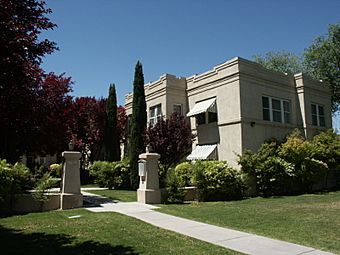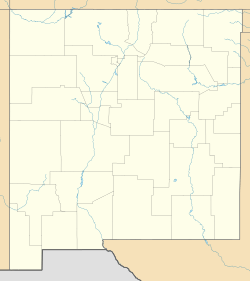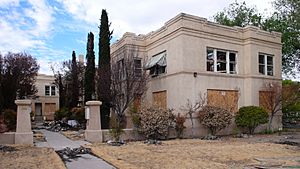Castle Apartments facts for kids
|
Castle Apartments
|
|

The Castle Apartments in 2004
|
|
| Location | 1410 Central Ave. SW, Albuquerque, New Mexico |
|---|---|
| Built | 1922 |
| Architect | Trost & Trost, George P. Hill |
| Demolished | 2010 |
| NRHP reference No. | 86000219 |
Quick facts for kids Significant dates |
|
| Added to NRHP | February 13, 1986 |
The Castle Apartments was a special apartment building in Albuquerque, New Mexico. It was a very old and important building. Sadly, a big fire destroyed it in 2009.
The apartments were located near Central Avenue. This spot was between Downtown and Old Town. The building got its name from a famous old house nearby. This house was called Huning Castle.
The Castle Apartments were built in 1922. It was a two-story building shaped like a "U". It had a central open area called a courtyard. There were 20 apartments inside, each about 600 to 750 square feet. The architects who designed it were Trost & Trost and George P. Hill. Because it was so important, the Castle Apartments were added to special lists. These lists protect historic places. It joined the New Mexico State Register of Cultural Properties in 1985. Then, it was added to the National Register of Historic Places in 1986.
Contents
History of the Castle Apartments
The apartments were built in 1922 by Arno Huning. He was the son of a well-known local businessman, Franz Huning. At that time, Albuquerque was growing fast. More and more people needed places to live. So, there was a big need for new apartments.
Arno Huning built the apartments on land that belonged to his father. This land was close to the Huning Castle mansion. That's why the apartments were named after the castle. Building the apartments cost about $75,000. This was a lot of money back then!
Newspaper ads from that time said the apartments would "help to fill a long felt need." They promised homes for people with "exacting requirements." This meant the apartments were built to be very nice. They were designed to be elegant and high-quality. Because of this, the Castle Apartments were a popular place to live for many years.
How the Apartments Looked
The Castle Apartments were designed by a company called Trost & Trost. George P. Hill also helped with the design. The building had two stories and was shaped like a "U". The open courtyard faced Central Avenue.
The front of the building looked balanced and even. It had two parts that stuck out on the sides. There was also one in the middle. Each of these parts had a triangular top, called a pediment. The building also had simple decorations. These included moldings and a slightly bumpy top edge, called a parapet. The outside walls were covered in a cream-colored stucco. There were also over 100 original windows with wooden frames. These were called sash windows.
Inside, there were 20 apartments. Some had one bedroom, and some had two. They were about 600 to 750 square feet (56–70 m2). Each apartment had tall ceilings, about 9 feet (2.7 m) high. They also had hardwood floors. A boiler in the building's corner provided central steam heating.
People living on the second floor used inside staircases to get to their homes. First-floor apartments could be entered from the courtyard. They also had doors from the inside hallways. When the building was destroyed, many of its original inside decorations and door handles were still there. There was also a separate garage building with 10 parking spots.
Fire and What Happened Next
A big fire started at the Castle Apartments on August 4, 2009. It began around 8 p.m. The fire quickly spread through the whole building. This happened because the fire traveled through the shared attic space.
Thirteen fire trucks came to help. About 50 firefighters worked hard to put out the fire. They fought the blaze for almost a full day. Luckily, no one was hurt in the fire. But the historic apartments were completely burned inside.
At first, the building's owners hoped to fix it. However, they could not find a way to pay for the repairs. It was too expensive. So, the burned building had to be torn down. This happened in July 2010. Now, a bank building stands where the Castle Apartments used to be.
Interestingly, TV footage of this fire was used in the show Breaking Bad. The show was filmed in Albuquerque. The fire footage was used to show an airplane crash in one of the episodes.
Images for kids





